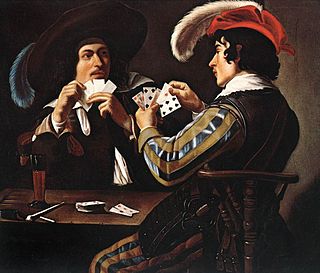A game try (also called a game trial bid) in the card game of bridge is a bid that shows interest in bidding a game and asks partner to help in making the decision.

A card game is any game using playing cards as the primary device with which the game is played, be they traditional or game-specific.

Contract bridge, or simply bridge, is a trick-taking card game using a standard 52-card deck. In its basic format, it is played by four players in two competing partnerships, with partners sitting opposite each other around a table. Millions of people play bridge worldwide in clubs, tournaments, online and with friends at home, making it one of the world's most popular card games, particularly among seniors. The World Bridge Federation (WBF) is the governing body for international competitive bridge, with numerous other bodies governing bridge at the regional level.
Contents
- With a major suit fit
- With a minor suit fit
- If opener has a weak hand
- If opener has a very strong hand
- Other methods of "trying" for game
- References
For example, (using Acol or Standard American bidding) if opener, with around 16-17 HCP, bids 1♥ and partner responds 2♥ (showing 6 – 9 support points) opener is in a quandary: if responder has a maximum strength hand, with well-positioned high cards, then game will probably make; but the information revealed so far is not accurate enough for either partner to decide whether to play in game or only part score.
Acol is the bridge bidding system that, according to The Official Encyclopedia of Bridge, is "standard in British tournament play and widely used in other parts of the world". It is a natural system using four-card majors and, most commonly, a weak no trump.
Standard American is a bidding system for the game of bridge widely used in North America and elsewhere. Owing to the popularization of the game by Charles Goren in the 1950s and 1960s, its earliest versions were sometimes referred to simply as 'Goren'. With the addition and evolution of various treatments and conventions, it is now more generally referred to as Modern Standard American. It is a natural bidding system based on five-card majors and a strong notrump; players may add conventions and refine the meanings of bids through partnership agreements summarized in their convention card. One standardised version, SAYC, is widely used by casual partnerships and in online bridge.
In contract bridge, various bidding systems have been devised to enable partners to describe their hands to each other so that they may reach the optimum contract. Key to this process is that players evaluate and re-evaluate the trick-taking potential of their hands as the auction proceeds and additional information about partner's hand and the opponent's hands becomes available.
Originally, opener would make a game try by bidding 3♥ (inviting game) and responder would then bid game with maximum (8-9) points or pass with minimum (6-7) points. Modern game try bids permit more accurate decision-making. Following a simple raise by partner (e.g. 1♥ – 2♥), opener bids a new suit either to show extra values or to ask responder to show more about his values. There are a variety of methods to do so including long suit, short suit, or help suit game tries and partnership agreement is required. [1]
Whichever method is adopted, responder and opener will collaborate to evaluate the additional information and make one of the following choices: sign off in three of the agreed major; jump to game in the agreed major; jump to game in notrump if the suit is a minor; or make a counter try in yet another new suit. When opener has a very strong hand, slam investigation may also be undertaken.